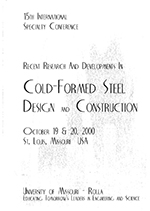Session Dates
19 Oct 2000
Abstract
A series of tests on cold-formed unlipped channels subjected to web crippling is presented in this paper. The tests were conducted under the four loading conditions specified in the Australian/New Zealand Standard (AS/NZS 4600, 1996) and the American Iron and Steel Institute (AISI, 1996) Specification for cold-formed steel structures. The four specified loading conditions are the End-One-Flange (EOF), Interior-One-Flange (IOF), End-Two-Flange (ETF) and Interior-Two-Flange (ITF) loading. The loading of concentrated load or reaction forces were applied by means of bearing plates which acted across the full flange widths of the channels. The web slenderness values of the tested channel sections ranged from 15.3 to 45. The flanges of the channels were not fastened to the bearing plates. The test strengths are compared with the design strengths obtained using the AS/NZS 4600 and the AISI Specification. It is demonstrated that the design strengths predicted by the standard and the specification are generally unconservative for unlipped channels. Test strengths as low as 37% of the design strengths were obtained. New web crippling design equations for unlipped channels are proposed in this paper. The proposed design equations are derived based on a simple plastic mechanism model, and the web crippling strength is obtained by dispersing the bearing load through the web. Factors to account for the variation of the web slenderness are also incorporated in these equations. The proposed design equations are calibrated with the test results. It is shown that the web crippling strengths predicted by the proposed design equations are generally conservative for unlipped channels with web slenderness values of less than or equal to 45. The reliability of the current design rules and the proposed design equations used in the prediction of web crippling strength of cold-formed channels are evaluated using reliability analysis. The safety indices of the current design rules for different loading conditions are found to be much lower than the target safety index specified in the AISI Specification, while the safety indices of the proposed design equations are generally higher than the target value.
Department(s)
Civil, Architectural and Environmental Engineering
Research Center/Lab(s)
Wei-Wen Yu Center for Cold-Formed Steel Structures
Meeting Name
15th International Specialty Conference on Cold-Formed Steel Structures
Publisher
University of Missouri--Rolla
Document Version
Final Version
Rights
© 2000 University of Missouri--Rolla, All rights reserved.
Document Type
Article - Conference proceedings
File Type
text
Language
English
Recommended Citation
Young, Ben and Hancock, Gregory J., "Tests and Design of Cold-formed Unlipped Channels Subjected to Web Crippling" (2000). CCFSS Proceedings of International Specialty Conference on Cold-Formed Steel Structures (1971 - 2018). 4.
https://scholarsmine.mst.edu/isccss/15iccfss/15iccfss-session2/4
Tests and Design of Cold-formed Unlipped Channels Subjected to Web Crippling
A series of tests on cold-formed unlipped channels subjected to web crippling is presented in this paper. The tests were conducted under the four loading conditions specified in the Australian/New Zealand Standard (AS/NZS 4600, 1996) and the American Iron and Steel Institute (AISI, 1996) Specification for cold-formed steel structures. The four specified loading conditions are the End-One-Flange (EOF), Interior-One-Flange (IOF), End-Two-Flange (ETF) and Interior-Two-Flange (ITF) loading. The loading of concentrated load or reaction forces were applied by means of bearing plates which acted across the full flange widths of the channels. The web slenderness values of the tested channel sections ranged from 15.3 to 45. The flanges of the channels were not fastened to the bearing plates. The test strengths are compared with the design strengths obtained using the AS/NZS 4600 and the AISI Specification. It is demonstrated that the design strengths predicted by the standard and the specification are generally unconservative for unlipped channels. Test strengths as low as 37% of the design strengths were obtained. New web crippling design equations for unlipped channels are proposed in this paper. The proposed design equations are derived based on a simple plastic mechanism model, and the web crippling strength is obtained by dispersing the bearing load through the web. Factors to account for the variation of the web slenderness are also incorporated in these equations. The proposed design equations are calibrated with the test results. It is shown that the web crippling strengths predicted by the proposed design equations are generally conservative for unlipped channels with web slenderness values of less than or equal to 45. The reliability of the current design rules and the proposed design equations used in the prediction of web crippling strength of cold-formed channels are evaluated using reliability analysis. The safety indices of the current design rules for different loading conditions are found to be much lower than the target safety index specified in the AISI Specification, while the safety indices of the proposed design equations are generally higher than the target value.



